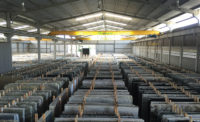While the Safra factory sits on 19,000 square meters and has 49 workers, the Mont Libano location spans 120,000 square meters and includes a 40,000-square-meter factory with 65 workers. “If it wasn’t for the employees’ invaluable contributions, Santo Antonio’s development would not have had the accomplishment and growth that it has experienced over the last decades,” said Araldi. “From the cradle to today, transformations in the national and international economic environment were significant, surely interfering directly on the company’s [success].”
The company produces 2 cm and 3 cm slabs with polished and honed finishes, as well as a brushed — or “leather” finish — for granite and quartzite. Material is processed on a line-up of state-of-the-art machinery.
Santo Antonio’s facility is equipped with two Gaspari multi-wire saws — one with 68 wires cutting at 2 cm and the other with 51 wires cutting at 3 cm. The saws can cut a full-sized block in approximately 4 to 5 hours. The production process also includes two polishing lines and two automatic resin lines, all four machines made by Gaspari.
Santo Antonio operates over 25 different quarries, from which over 30 materials are extracted. After the blocks are processed into raw slabs, they are honed and calibrated on an automated T&F line from Italy. From there, certain materials receive an application of resin products from Tenax and are then cured in a large-scale oven, which is capable of accommodating 130 exotic lines at one time. A fiberglass netting is also applied to some materials as needed. When it comes to exotic materials, Santo Antonio has a slab consolidation process. The back of each slab is reinforced using resin that is mixed with a powder that was created directly from the specific stone being treated, ensuring a perfect color match. For the process, the pieces of the raw slab are carefully lined up, dried, and then the resin/powder mixture is applied by hand. Then the slab is honed and undergoes the same production process as the more traditional resin-treated materials. Once the resin is applied and cured, the slabs are delivered to the final polishing line.
The company sells to distributors worldwide, including direct sales to the U.S. market. Its principal markets right now for slabs are: 80% to the U.S., 10% to Canada, 3% to Latin America and 7% to other countries. For blocks, the company sells 50% to Europe, 30% to Asia and 20% to India.
According to Araldi, throughout the company’s history, another basic element responsible for the constitution of Santo Antonio’s institutional heritage was the constant search for knowledge, many times stored, evaluated, transformed and transmitted in actions related to its bigger vocation, the production of marble and granite with excellence. “Born as a challenging enterprise, Santo Antonio Granitos seems to carry the destiny of its origins: constant renewal and the recognition of the heritage as a result of its trajectory are necessary to move forward,” said Araldi. “Therefore, it finds the need to start up new paths and build fresh history.”







